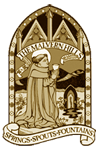Who are our Friends? Friends promote research, conservation and celebration of the Springs, Spouts, Fountains and Holy Wells of the Malvern Hills and of Great Malvern as a
Spa
Town. If you would like any back numbers of our Newsletters send a large SAE to Bruce with details of which ones you require. There is no charge and they are now collector's items!
INFORMATION UPDATE - SHAW'S MULBERRY TREE
The good news is that on Friday 14th August Oliver Weaver was able to collect the Mulberry Tree saplings from
London
Heathrow
Airport. All documentation, quarantine and other import requirements were met and the parcel was released on the Friday afternoon. We can report that six saplings soon afterwards arrived in Malvern
UK after the long journey from
Malvern,
Australia. They are now being distributed to selected locations for acclimatisation and rearing to plantable trees. In the picture Cora shows the packaging and two of the already shooting saplings. For further information on this epic story go to our new Mulberry Tree web site by clicking on the tree right. Here you can read the background to this Friends of Malvern Springs and Wells project to reinstate G B Shaw's Mulberry Tree in Malvern
UK.
acclimatisation and rearing to plantable trees. In the picture Cora shows the packaging and two of the already shooting saplings. For further information on this epic story go to our new Mulberry Tree web site by clicking on the tree right. Here you can read the background to this Friends of Malvern Springs and Wells project to reinstate G B Shaw's Mulberry Tree in Malvern
UK.
Mystery - Wendy Hiller the actress (1912-2003) appeared at the 1936 Malvern Festival honouring Irish playwright George Bernard Shaw's 80th birthday, taking leading parts in his Pygmalion and Saint Joan. Her performance was legendary albeit with only six rehearsals for each show. In July 1956 the ATV Midlands News recorded the actress unveiling a plaque in Malvern to mark the centenary of the birth of Shaw. This took place at a garden party held in
Priory
Park, Malvern. Wendy Hiller is seen unveiling a small plaque next to the mulberry tree that was planted by Shaw in 1936. WHERE IS THIS 1956 PLAQUE NOW? DO YOU KNOW? IF SO LET US KNOW. DO YOU HAVE A PICTURE?
THIS 1956 PLAQUE NOW? DO YOU KNOW? IF SO LET US KNOW. DO YOU HAVE A PICTURE?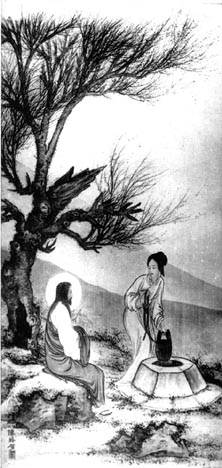
This newsletter is an appropriate opportunity to thank all concerned in bringing the Mulberry Tree project to this stage. In particular we thank Oliver Weaver for a most frustrating time in arranging import and collecting the saplings from Heathrow. This would not have been possible without the support of the city of
Stonnington and the local mayor in Australia Cr. Claude Ullin and his team. There is Anne and Neil Thomas who located the Australian offspring of the original Shaw tree and many others who have participated in pursuing this project. Also we should not forget our sponsors Malvern, The Original, English Water from Colwall, who have resolved the problem of the costs involved.
Chinese interpretation of Malvern Springs?
The text on the original 19th century plaque at Ellerslie Fountain states 'Jesus saith unto her whosoever drinketh of this fountain shall thirst again but whosoever drinketh of the water that I shall give unto him shall never thirst'. This biblical quotation from St John Ch.4 has been welcoming visitors to Malvern's famous fountain for 150 years. It is Jesus's words to a Samaritan woman at Jacob's Well in Sychar,
Samaria. We each have our own vision of the people who are participant in this biblical reference and it comes as a surprise when we see alternative cultural interpretation. We stumbled on this piece of Chinese art recently of 'The Woman at the Well' and found the imagery so intriguing that we thought it worth sharing. With world tourism now handling many Chinese travellers we should perhaps start preparing Chinese versions of many of our texts and illustrations!
No Bathers Required
Those two warming words 'hot' and 'springs' are like little magnets, and it was the resort and spa of Hot Springs, North Carolina that drew us to it recently. This has been a resort destination for almost 200 years and has long been renowned for its healing mineral springs and scenic mountain setting. Native Americans were the first to utilise the hot mineral water. Just 40 minutes north of
Asheville, the resort is located at the junction of the Appalachian Trail and the
French Broad
River in a valley surrounded by the
Blue Ridge Mountains. The resort has a chequered history with several hotels being burnt and replaced over the years. By May 1917, fewer and fewer people were taking the waters, and the grandiose Mountain Park Hotel and grounds were leased to the federal government as an internment camp for hundreds of German merchant sailors captured when war was declared. Many of the internees stayed on after cessation of hostilities. After the war the spa arose, like a phoenix, from the ashes of the Mountain Park Hotel. Today's advertising brochure warns that, '...you will truly feel rejuvenated by both the setting and our water', so we decided to try them out. 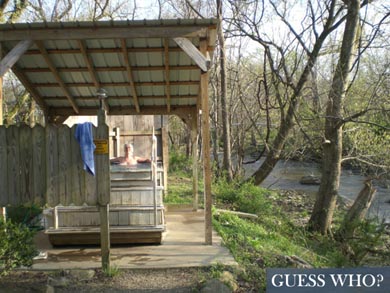 Those seeking time for relaxation can simply savour the area's breathtaking scenery while soaking in hot mineral baths in secluded outdoor tubs at the newly reopened Hot Springs Spa. For a few dollars we hired a tub and a huge fluffy towel apiece. The jacuzzi tubs are in wooden shelters, a little distance apart from each other for privacy, all under trees and all beside or in sight of the delightful river and the archaeology of former glory. What a wonderful setting for a soak in the 102 degrees F natural spring water.
Those seeking time for relaxation can simply savour the area's breathtaking scenery while soaking in hot mineral baths in secluded outdoor tubs at the newly reopened Hot Springs Spa. For a few dollars we hired a tub and a huge fluffy towel apiece. The jacuzzi tubs are in wooden shelters, a little distance apart from each other for privacy, all under trees and all beside or in sight of the delightful river and the archaeology of former glory. What a wonderful setting for a soak in the 102 degrees F natural spring water.
St Ethelbert's Well at
Hereford - a local site
Jeremy Harte of
Bourne
Hall
Museum in Surrey has provided details of this interesting well at
Hereford. The source is recorded in medieval times and in 1250 is mentioned in a deed to a property adjoining 'a road leading towards the former fountain of blessed St. Ethelbert" St. Ethelbert, King of the East Angles, was killed by Offa in 794, a death which was regarded as martyrdom when he was enshrined at Hereford Cathedral.
William Stukeley in 1721 noted 'by the side of the ditch arose a spring, which superstition consecrated to St. Ethelbert, there is a handsome old stone arch erected over it'. His sketch was published by the Anastatic Drawing Society in 1855. In 1802 the well 'appears on a plan.... drawn as a circular feature enclosed by walls and approached by five stone steps. It was situated in the eastern corner of a garden soon to be occupied by St. Ethelbert's House'. There is a description from the early 19th century of 'a beautiful limpid spring, formerly much reverenced; and even now in great esteem for its medicinal properties. The well is now provided with a pump erected and kept in repair during her life-time, by the late Johanna Whitmore, of this city. In cleaning it out for that purpose, a great quantity of pins were found in its bottom'. The water had medicinal properties and was reputed to be of service to persons afflicted with bad eyes, ulcers, and sores of various kinds. The water was analysed by Mr. J. Murray in December 1822 but his opinion was that the medicinal qualities were not very important.
By 1869 the superstructure had long since disappeared, and the well itself entirely excluded from sight by four brick walls and a vast accumulation of rubbish. By the early 20th century the original site was stopped up, although a circular stone within the
garden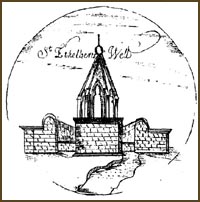 of
Mr. Custos Eckett's house marked the exact position. The waters were diverted to a drinking fountain built by Mr. A. Steel near the bank of the river, on the left hand side of the entrance to the Castle Green from
Quay Street. In the early twentieth century, four sites could lay claim to being the well. In addition to the circular stone where the medieval well-house had been, and the new drinking fountain, there were two others - 'a pump and well in Dr. Du Buisson's yard in the line of the ditch, and a flowing spout of water, formerly running close under Castle Cliffe house which ceased to flow on being cut off in laying a main sewer in 1888. The drinking fountain erected in 1904 was restored by the Hereford Civic Trust and rededicated by the Right Reverend J.R.G. Eastaugh, the Lord Bishop of
Hereford on St. Ethelbert's Day, 20 May 1978. The spring water was pumped to the fountain but it dried up during building works after the war. The 1632 picture by Thomas Dingley may be the only view of a mediaeval holy well with its own wellhead. It looks 14th-century. What is apparent is that the restoration of holy wells is nothing new.
of
Mr. Custos Eckett's house marked the exact position. The waters were diverted to a drinking fountain built by Mr. A. Steel near the bank of the river, on the left hand side of the entrance to the Castle Green from
Quay Street. In the early twentieth century, four sites could lay claim to being the well. In addition to the circular stone where the medieval well-house had been, and the new drinking fountain, there were two others - 'a pump and well in Dr. Du Buisson's yard in the line of the ditch, and a flowing spout of water, formerly running close under Castle Cliffe house which ceased to flow on being cut off in laying a main sewer in 1888. The drinking fountain erected in 1904 was restored by the Hereford Civic Trust and rededicated by the Right Reverend J.R.G. Eastaugh, the Lord Bishop of
Hereford on St. Ethelbert's Day, 20 May 1978. The spring water was pumped to the fountain but it dried up during building works after the war. The 1632 picture by Thomas Dingley may be the only view of a mediaeval holy well with its own wellhead. It looks 14th-century. What is apparent is that the restoration of holy wells is nothing new.
A FRIEND COMMENTS ON ABORTED LABYRINTH PROJECT AND MULBERRY TREE
You invite replies as to the issue of where to plant the new mulberry tree cuttings, once ready for planting. As the original tree was associated with a man of the theatre, I feel it should still be within reach of the theatre....or a theatre. However, if it is to be planted near a spring or well, and so takes up fresh associations, it would be good if it could be somewhere accessible for everyone to admire, rather than, say, tucked out of the way up in the hills.
I understand how you feel with regard to the local council regarding the labyrinth. Anyway, it will be interesting to see what others say in response to your question!
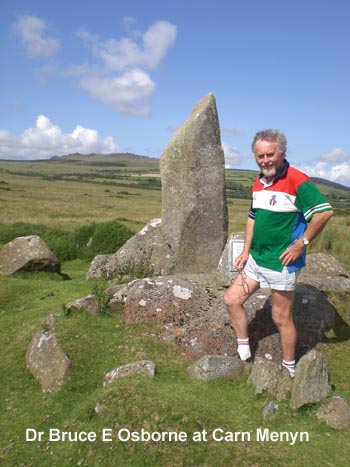 We are pleased to report that since receiving this communication we are now in discussions with Malvern Hills District Council regarding eventual location of a Shaw Mulberry and
Priory
Park is an obvious consideration.
We are pleased to report that since receiving this communication we are now in discussions with Malvern Hills District Council regarding eventual location of a Shaw Mulberry and
Priory
Park is an obvious consideration.
Sacred Springs and Stone Circles - just a stone's throw away.
The Preseli Hills in the
Pembrokeshire
Coast
National Park are now believed to be the source of the Bluestones. The Bluestones are a collection of assorted stones that were used in the building of
Stonehenge on the Salisbury Plain. They are distinct in that they are not stones of local origin to
Stonehenge. Recent archaeological scholarship has failed to produce a single hypothesis as to how the Bluestones got to the Salisbury Plain.
There are three principal theories. Timothy Darvill argues that the Bluestones were transported by ancient Britons across land and water. They originated on Carn Menyn in the Pembrokeshire Preseli Hills and this was a sacred place with healing springs and stone circles that the ancients sought to replicate at
Stonehenge. Brian John argues that they were the result of glaciations during the Ice Ages and that they were transported to the Salisbury Plain by ice action. The ancient Britons merely collected up stones that were available locally to utilise in their unique structure as it developed in its various stages over thousands of years. Our own in house 'expert' Bruce Osborne argues that the Bluestones were transported by the action of a cataclysmic event at the end of the Ice Ages approximately 12,000 years ago. This event was of celestial origin and resulted in a mass upheaval of land, weather and life itself, which was practically extinguished as a result.
Whatever the mechanics of the movement of the Bluestones, it is well worth a couple of days out to explore the Preseli Hills in South West Wales. Being a protected landscape in the
Pembrokeshire
National Park it is possible to visit the locality and see the surviving stone circles and the outcrops of Bluestone. In particular the north-south road between Pont Mynachlog-ddu and Crymych gives access points to various key sites. If you are interested in the academic arguments have a look at the web site where there are guides to further reading do a key word search for Preseli on this web site.
Malvern Water Painted by twelve year old Kieron

A year 7 pupil from
Chase
Technology
College has won a competition to design an 8ft x 4ft mural to sit in the grounds of the Malvern Water bottling plant in Colwall. Twelve year old Kieron Young won the competition hosted by Coca-Cola Enterprises - who produce Malvern Water at the Colwall site, to design a mural welcoming visitors to the site and emphasising the significance of the brand to the local area, in an historical and geographical context. The competition, open to all year 7 pupils, required the students to produce concept designs to a brief. The designs were then short listed and a winner and runner up selected by a panel of judges, with the winning concept realised and turned in to the finished mural by a local graphic design company Artwork Creative. Rob Stilliard - Operations Manager at Colwall said 'The standard and creativity of the work from all of the pupils was amazing making the judging a far more challenging task than expected.'
Were the Malvern Hills
Britain's first National Park?
 The modern perception of a National Park resulted from pre-war measures to protect the countryside and to provide access for the urban population of
Britain's industrial towns and cities. The Second World War delayed the implementation of such designation although detailed proposals were well advanced. After the war there was great deprivation as we recovered from the conflict and the new National Parks were seen as something that was worth fighting for with the associated sacrifice of life. The year 1951 saw a number of designations confirmed and the National Park movement was at last underway.
The modern perception of a National Park resulted from pre-war measures to protect the countryside and to provide access for the urban population of
Britain's industrial towns and cities. The Second World War delayed the implementation of such designation although detailed proposals were well advanced. After the war there was great deprivation as we recovered from the conflict and the new National Parks were seen as something that was worth fighting for with the associated sacrifice of life. The year 1951 saw a number of designations confirmed and the National Park movement was at last underway.
Or was it that simple? No, the Victorians had got there a lot earlier in the 19th century. Although not named a National Park, the Malvern Hills could arguably be called
Britain's first National Park being established with its own statutory administrative body and countryside protection initially under an Act of Parliament of 1884 with subsequent amendments. With its priorities on public access and conservation, the
Malvern Hills were well established as a specially protected area by the dawn of the 20th century. The Malvern Hills Conservators were empowered by an Act of Parliament that enabled them to resist everything from intrusion by major new road schemes, water company projects and urbanisation. In addition access by the public was and remains top of their agenda.
Although only covering 12 square kilometres and tiny in comparison, the Malvern Hills have certainly set the template for the 15 National Parks throughout Great Britain and are now included on the BritishNationalParks.com web site. Ian Rowat, Director of the Malvern Hills Conservators has given his view as follows '....the
Malvern Hills Conservators have been doing the job for 125 years!' Let us have your views.
Email: springs@thespas.co.uk (click here to send an email)



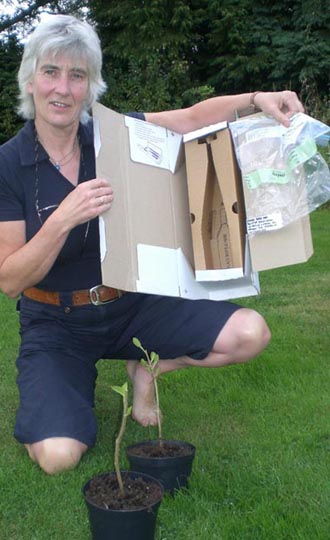
 acclimatisation and rearing to plantable trees. In the picture Cora shows the packaging and two of the already shooting saplings. For further information on this epic story go to our new Mulberry Tree web site by clicking on the tree right. Here you can read the background to this Friends of Malvern Springs and Wells project to reinstate G B Shaw's Mulberry Tree in Malvern
acclimatisation and rearing to plantable trees. In the picture Cora shows the packaging and two of the already shooting saplings. For further information on this epic story go to our new Mulberry Tree web site by clicking on the tree right. Here you can read the background to this Friends of Malvern Springs and Wells project to reinstate G B Shaw's Mulberry Tree in Malvern
 THIS 1956 PLAQUE NOW? DO YOU KNOW? IF SO LET US KNOW. DO YOU HAVE A PICTURE?
THIS 1956 PLAQUE NOW? DO YOU KNOW? IF SO LET US KNOW. DO YOU HAVE A PICTURE?
 Those seeking time for relaxation can simply savour the area's breathtaking scenery while soaking in hot mineral baths in secluded outdoor tubs at the newly reopened Hot Springs Spa. For a few dollars we hired a tub and a huge fluffy towel apiece. The jacuzzi tubs are in wooden shelters, a little distance apart from each other for privacy, all under trees and all beside or in sight of the delightful river and the archaeology of former glory. What a wonderful setting for a soak in the 102 degrees F natural spring water.
Those seeking time for relaxation can simply savour the area's breathtaking scenery while soaking in hot mineral baths in secluded outdoor tubs at the newly reopened Hot Springs Spa. For a few dollars we hired a tub and a huge fluffy towel apiece. The jacuzzi tubs are in wooden shelters, a little distance apart from each other for privacy, all under trees and all beside or in sight of the delightful river and the archaeology of former glory. What a wonderful setting for a soak in the 102 degrees F natural spring water.
 We are pleased to report that since receiving this communication we are now in discussions with Malvern Hills District Council regarding eventual location of a Shaw Mulberry and
We are pleased to report that since receiving this communication we are now in discussions with Malvern Hills District Council regarding eventual location of a Shaw Mulberry and

 The modern perception of a National Park resulted from pre-war measures to protect the countryside and to provide access for the urban population of
The modern perception of a National Park resulted from pre-war measures to protect the countryside and to provide access for the urban population of
 Newsletter Archive which can also be accessed from our WEB SITE INDEX.
Newsletter Archive which can also be accessed from our WEB SITE INDEX.
